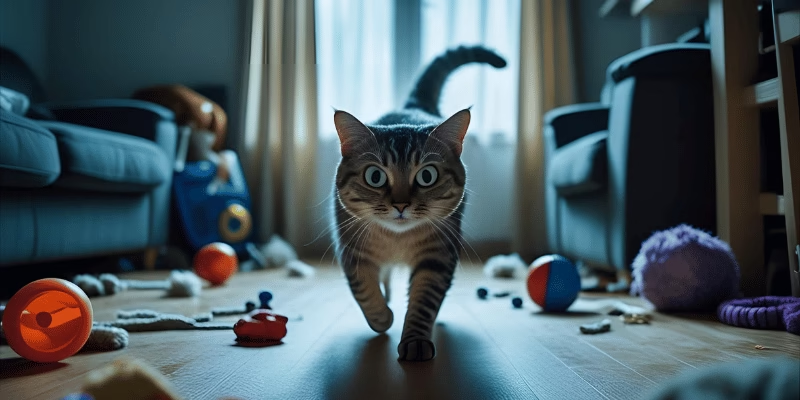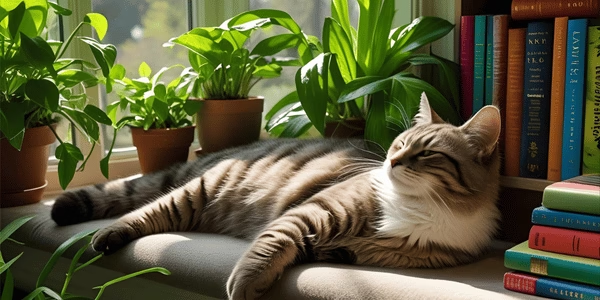Page 4 of 4
Your Complete Cat Transformation System
After implementing the emergency solutions from page 3, you’re ready for the comprehensive approach that creates lasting change and prevents future behavioral problems.
This is where most cat owners either succeed completely or continue struggling with recurring issues. The difference lies in understanding that sustainable behavior change requires both environmental management AND behavioral retraining.
The 30-Day Complete Transformation Protocol
Week 1: Foundation Building
Days 1-3: Assessment and Immediate Safety
-
Document all current behavioral issues with photos/videos
-
Implement emergency stress-reduction changes from page 3
-
Establish new daily routines for feeding and play
-
Begin pheromone therapy in main living areas
Days 4-7: Environmental Optimization
-
Add vertical territory options (cat trees, shelves)
-
Create distinct resource zones for each cat
-
Eliminate territorial stress triggers (blocking outdoor cat views)
-
Install additional hiding spots and comfort areas
Week 2: Behavioral Retraining
Positive Association Building:
-
Feed cats near previously problematic areas (at safe distance)
-
Use high-value treats in areas where accidents occurred
-
Engage in positive play sessions throughout the house
-
Reward appropriate elimination with immediate treats
Stress Trigger Desensitization:
-
Gradually expose cats to low-level versions of stress triggers
-
Pair exposure with positive experiences (treats, play, attention)
-
Increase exposure slowly as cats show comfort
-
Never force interactions or proximity between conflicted cats
Week 3: System Integration
Multi-Cat Household Management:
-
Establish separate daily routines for each cat if needed
-
Create positive associations between cats using feeding protocols
-
Implement parallel activities (simultaneous but separate play sessions)
-
Monitor for improvements in silent conflict behaviors
Single Cat Optimization:
-
Increase environmental enrichment and mental stimulation
-
Address any remaining territorial insecurities
-
Fine-tune daily routines based on observed preferences
-
Maintain consistency in all environmental management
Week 4: Long-Term Success Planning
Behavior Maintenance:
-
Establish permanent environmental management systems
-
Create crisis prevention protocols for household changes
-
Develop early warning sign recognition skills
-
Plan for ongoing environmental enrichment rotation
The Elimination Problem Solution
Here’s the hard truth: While environmental management helps 70% of cats improve, cats with established elimination problems often need specialized behavioral retraining that goes beyond environmental changes.
Why Most Solutions Fail:
-
They address environment but not learned behaviors
-
Cats have already developed negative associations with litter boxes
-
Stress triggers remain unidentified and unaddressed
-
Owners lack the specific retraining protocols needed for success
Cat Spraying No More provides the missing piece: a complete behavioral modification system that has helped over 50,000 cat owners permanently stop inappropriate elimination. The system includes:
✅ Stress trigger identification protocols to find hidden causes of elimination problems
✅ Step-by-step retraining techniques that rebuild positive litter box associations
✅ Multi-cat household management strategies for territorial marking issues
✅ Crisis prevention plans to stop problems from recurring
✅ 24/7 support access for troubleshooting difficult cases
Success Metrics to Track
Week 1 Improvements:
-
Reduced hiding and increased confidence
-
Return to normal eating and drinking patterns
-
Decreased vocalization and stress signals
-
Initial reduction in inappropriate elimination incidents
Week 2-4 Transformations:
-
Consistent appropriate elimination behavior
-
Improved social interactions between cats
-
Increased play and exploration behaviors
-
Stable daily routines and predictable responses
Long-Term Success Indicators:
-
Complete elimination of inappropriate urination/spraying
-
Confident, relaxed body language and behavior
-
Positive social interactions with family members
-
Resilience to minor household changes
When Professional Help Is Essential
Contact a veterinary behaviorist immediately for:
-
Aggressive behaviors that pose safety risks
-
Complete social withdrawal lasting more than a week
-
Self-destructive behaviors (excessive grooming, eating disorders)
-
Multiple cats with severe territorial conflicts
For elimination problems specifically: Many families find success combining environmental management with Cat Spraying No More’s specialized elimination protocols (now available with 30% limited-time discount). The system’s behavioral retraining component addresses the learned behaviors that environmental changes alone cannot fix.
Your Cat’s Future Depends on Action Today
Every day you wait is another day your cat suffers from chronic stress. The research is clear: stressed cats don’t improve on their own. Without intervention, stress-related behaviors intensify as cats develop stronger negative associations and their stress hormones remain chronically elevated.
The choice is yours:
-
Continue trying random solutions and hoping for improvement
-
Address the complete problem with proven environmental AND behavioral interventions
Your cat isn’t broken. They’re not spiteful. They’re not “bad.” They’re stressed, anxious, and desperately trying to communicate their needs through the only methods available to them.
Give your cat the peace they’re begging for. Environmental management provides the foundation, but for cats with established behavioral problems, Cat Spraying No More provides the specialized retraining system that creates lasting change.
The stress stops when you understand what your cat really needs. What they need is an owner who recognizes that inappropriate elimination is a symptom, not the problem itself, and who takes comprehensive action to address both the environment AND the learned behaviors that perpetuate the cycle.
Important Medical Notice: This article provides educational information about feline stress and behavior. Always consult with a veterinarian to rule out medical causes of inappropriate urination before implementing behavioral interventions.





